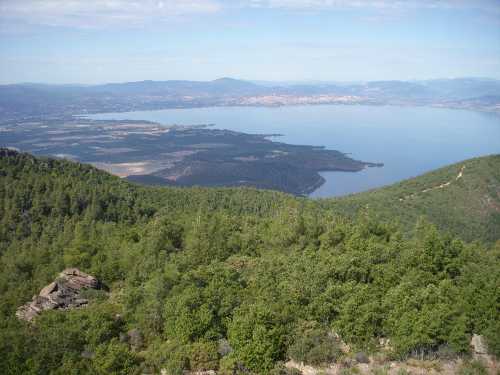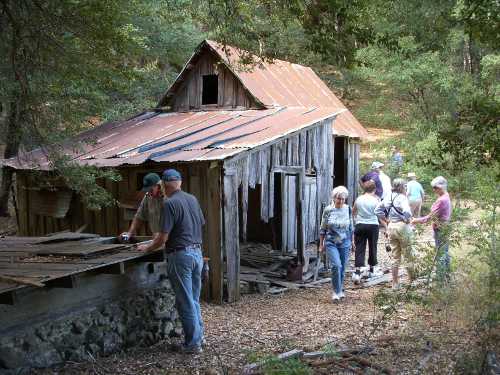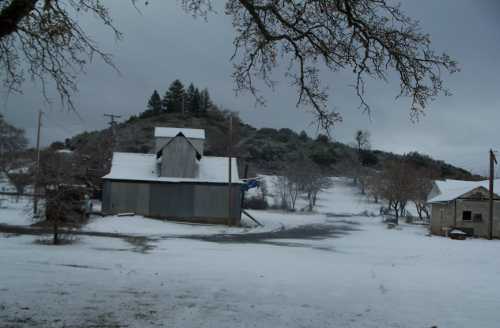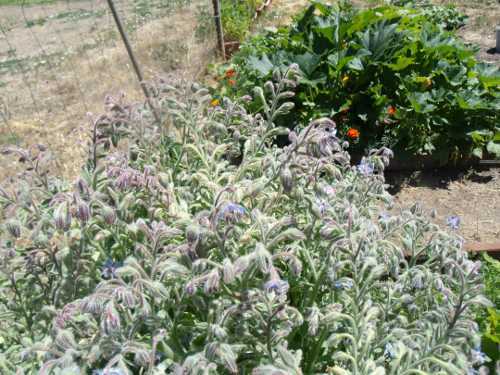
Borage is easily grown in backyard gardens, such as this plant in the garden of Ann Martin of Kelseyville, Calif. Fine hairs cover borage leaves. Photo by Esther Oertel.
Starflower and bee bread, two of the herb borage’s aliases, are inspired by its five-pointed flowers, which are immensely attractive to honey bees. If you happen upon a borage plant in bloom, chances are bees will be busy burrowing into its enticing blue blossoms.
Because of its classic “herby” look, borage is one of the most photographed culinary herbs, and is often represented in art such as tapestries, needlepoint and painted ceramics.
Traditionally, cultivation of borage was for medicinal and culinary uses. Today, however, most commercial production is for the oil obtained from its seeds, providing the highest plant-based source of gamma-linolenic acid, which is marketed as a remedy for inflammation and auto-immune diseases.
In addition to drying borage for use as an herb or tisane (an herbal tea), its beautiful Wedgewood-blue blossoms may be employed as an edible garnish for salads, fruit dishes, soups and desserts. They have a honey-like taste and are one of the few truly blue edible foods found in nature.
The leaves add a cucumber-like flavor to foods and blend well with garlic, mint and dill.
While not popular here for this purpose, borage is prized as a fresh vegetable throughout Europe, particularly in Germany, Spain, on the Greek island of Crete and in northern Italy.
German soups are made with borage, and a popular green sauce made with it hails from Frankfurt. In the Spanish regions of Aragon and Navarra, borage is boiled and sautéed with garlic.
It’s utilized as a filling for ravioli and other pasta in northern Italy’s Liguria, and as a pickling herb in Poland.
The Brits enjoy a gin-based cocktail known as Pimms that in its traditional form included borage blossoms. This once common garnish for the drink has given way to cucumber or mint, and while these may provide a similar flavor, I can’t imagine they substitute for the pleasing visuals of borage blossoms’ brilliant blue hue and enticing star shape.
Borage is easily grown in one’s backyard. In fact, it reseeds itself so prolifically that it’s more likely to take over a garden space than fail to thrive. It’s a recommended companion plant for legumes, strawberries, spinach, strawberries, tomatoes, and brassicas such as broccoli and cauliflower.
Tomatoes in particular benefit from it, since it confuses the moth mothers of tomato hornworms when looking for a place to lay eggs.
In ancient cultures, borage was known as an herb that induced courage and happiness. Roman author and naturalist Pliny has been credited with singing its praises and is quoted as saying, “A borage brew eliminates a person’s sadness and makes them glad to be alive.”
In Wales, borage was known as llanwenlys, meaning “herb of gladness,” and Celtic warriors drank borage-flavored wine to give them courage in battle. (Skeptics might wonder if it wasn’t the wine that induced courage.)
Borage leaves and blossoms are most often used raw, such as adding them to salads, while the stems are typically cooked, but stems and leaves can be used either way. For example, stems, leaves, or both may be sautéed in a bit of butter and garlic, the result of which is much like cooked spinach.
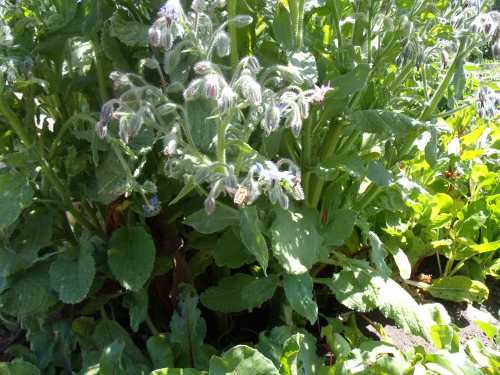
Borage plants are bee magnets, such as this one, which has attracted the insects to its hanging blue blossoms in the garden of Ann Martin of Kelseyville, Calif. Photo by Esther Oertel.
The leaves are covered with fuzzy hair, and chopping them finely can negate this if using them raw. When cooked, the hairy texture disappears.
Borage lemonade may be made by combining fresh lemon juice, sweetener of your choice to taste, water, and a few borage leaves in a blender. Blue borage blossoms floated on top will contrast nicely with the green of the drink.
Other creative uses for borage include making jelly from the leaves (mint may be added, if desired), and freezing the blossoms in ice for decorative cubes. If making jelly, pectin will be necessary.
Candied borage blossoms for decorating cakes and other desserts may be made by brushing blossoms with beaten egg whites and dipping in extra fine sugar and drying on waxed paper in a warm place.
When harvesting borage blossoms, first remove the thorny backside. Bees may be hidden among the hanging blooms, so use caution to avoid being stung.
Borage has been attributed as an herbal cure for a variety of ailments, including fever, bronchitis, diarrhea, and depression. The leaves have been found to contain small amounts of liver-toxic pyrrolizidine alkaloids; therefore it is recommended that ingestion in large quantities be avoided.
Today’s recipe for borage fritters (known in Italy as “frittelle di borragine”) is by Mario Batali, Food Network’s Iron Chef known for his affinity for bright orange chef clogs. If deep-frying is not your preferred method of cooking, prepare the fritters as you would ordinary pancakes.
Enjoy!
Borage fritters
2 eggs
½ cup flour
2 teaspoons baking powder
1 cup cold water
¼ cup grated Parmigiano-Reggiano cheese
Salt and pepper to taste
Bunch borage, cut into strips
Liter extra virgin olive oil, for frying
In a medium sized bowl, combine the eggs, flour, baking powder, water, cheese, and a pinch each of salt and pepper and whisk well to combine.
Cover and rest for at least two hours.
In a tall-sided, heavy-bottomed pot, heat the olive oil to 350 degrees F.
Stir the borage into the batter.
Drop by tablespoons into the hot oil and fry until golden brown. Remove from the oil with a slotted spoon and set on a plate lined with paper towels to drain.
Sprinkle with salt and serve immediately.
Makes four servings.
This recipe by Mario Batali is courtesy of www.FoodNetwork.com.
Esther Oertel, the “Veggie Girl,” is a culinary coach and educator and is passionate about local produce. Oertel teaches culinary classes at Chic Le Chef in Hidden Valley Lake, Calif., and The Kitchen Gallery in Lakeport, Calif., and gives private cooking lessons. She welcomes your questions and comments; e-mail her at This email address is being protected from spambots. You need JavaScript enabled to view it..
Follow Lake County News on Twitter at http://twitter.com/LakeCoNews, on Tumblr at www.lakeconews.tumblr.com, on Facebook at http://www.facebook.com/pages/Lake-County-News/143156775604?ref=mf and on YouTube at http://www.youtube.com/user/LakeCoNews.


 How to resolve AdBlock issue?
How to resolve AdBlock issue? 



